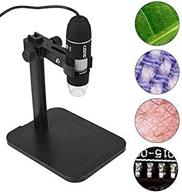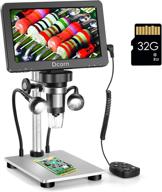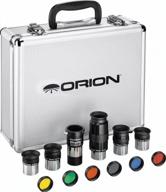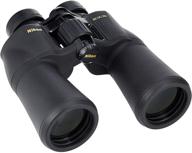
Review on 🔭 Gskyer Telescope 80mm AZ Space Astronomical Refractor, German Technology Scope for Adults and Kids Astronomy by Ken Hamdan

A very good entry-level scope that goes well with my other scopes
This is a review of the Gskyer 80mm refractor telescope. I'm not a Gskyer employee, I'm interested in astronomy. I have 3 other telescopes and binoculars. My review is based on this background and is a fair and honest review of the package for both daytime use as a telescope and astronomical night telescope. It includes an optical tube (telescope), mount/tripod, three eyepieces and 3x Barlow magnification. From my testing, it works well as binoculars during the day and as an astronomical telescope at night. Simple operation and stable bracket make it a good first look. The supplied eyepieces and Barlow offer a good range of magnifications. Its compact size makes it a good travel or travel scope for those with large telescopes. The Gskyer 80mm tripod/mount is solid, stable, easy to use and does the job well. Many entry-level telescopes have flimsy and shaky mounts/tripods that make it difficult to aim the telescope and result in a shaky image that is difficult to focus. The Gskyer 80 mount is the standout feature of this pack. Please note that the optics tube uses a dovetail mount, which means that this mount can be used with other optics tubes or other dovetail mount accessories in the future. It also includes a standard 1/4 20 bolt over mounting rings that can be used to mount a camera or other accessory. The finder uses a standard dovetail mount, allowing other finders to be used. It's a level of flexibility you don't typically find in a package at this price point. An optical tube is what you usually think of a telescope. OTA works well and gives a good picture. In a direct comparison, it performed well with my 80mm Meade scope. The focuser is easy to use and has a correct 45 degree diagonal image that gives the correct image you want to use as binoculars during the day. It also works well at night when comparing the sky to a map as the objects in the eyepiece are in the correct position. The scope uses the 1.25" standard most commonly used for telescope eyepieces, star diagonals and filters, so you can easily add accessories in the future. The included viewfinder works well. The mount is strong with enough adjustability to allow you to line it up with the optic tube assembly. Note that you will need to focus the viewfinder when you first take it out of the box. This is done by rotating the front black part. This is easy and only needs to be done once, but is not mentioned in the assembly sheet. You need to align the finder scope with the scope. This is a common procedure required by any telescope and is best done during the day. Find the target as far away as possible but no less than 500 feet. I like to use a telephone or utility pole cross brace. With a 25mm eyepiece, center the crosshead in the telescope eyepiece, not in the finderscope. Now use the two black screws on the finderscope to move the crosshairs until the target is in the center of the crosshairs. You are now aligned. This is very important for day and night use. You may need to make small adjustments from time to time, but that's okay. eyepieces. The supplied eyepieces deliver a good image and fit the scope well. The nice thing is that they are threaded for standard astronomical filters to improve your view of the moon, planets, nebulae and other objects. The eyepieces in combination with the included 3x Barlow magnification offer magnifications of 16x, 40x, 48x, 80x, 120x and 240x. For day spotting scopes, 16X and 40X are good choices. When the air is very still, 80x works well too, but it's the atmosphere that limits magnification, not the scope. For nighttime use, an 80mm scope will usually give you a maximum magnification of around 140-160x, but feel free to try 240x on the moon. Just remember that atmospheric transparency and turbulence is the limiting factor, not scale. And because the Gskyer 80mm uses the popular 1.25" eyepiece size, you can add any brand of fixed or zoom eyepieces, star diagonals or filters. What can you see with this kit? During the day I tested the scope and focused on maple leaves about 50 yards away, about half a football field. I could easily see the veins on the leaves. I haven't taken it to the shooting range but I assume it's good for target shooting. At 800 feet I could easily see the leaves on top of the tree and a bird perched on a branch. Many spotting scopes use zoom eyepieces so I tested it with the included eyepiece as well as my 8-24mm zoom eyepiece and got good results. As an astronomical telescope, it compared well to my other 80mm telescope. The mount is easy to align and the focuser makes it easy to focus. He worked well on Mars, Saturn and the rings, the moon and star clusters. I expect it to work well on Mercury, Venus, Jupiter and its moons, stars, star clusters and binaries. I enjoyed the Orion Nebula, the Pleiades, and other deep sky objects with an 80mm telescope. What you can see with a telescope depends in large part on the level of light pollution in your country and sky. I live in a very bright suburb of New York. Even under these difficult conditions, hundreds of star clusters, asterisms, and binaries enter this telescope's field of view, along with the Moon and bright planets. A darker area greatly expands the range of what you can see. This includes galaxies and nebulae that would be difficult to see with any telescope from a light-polluted location. Don't expect everything to look like the pictures in the magazines. They are created using long exposure astrophotography, often with false colors added, and do not represent what you would see through a telescope eyepiece many times larger. So, if you're looking for a compact, easy-to-carry, and easy-to-use telescope that can double as a spotting scope by day and an astronomical telescope by night, the Gskyer 80mm refractor should serve you well. And because it uses a standard 1.25" eyepiece and diagonal size, you can add eyepieces, filters, star diagonals, and other accessories in the future. You can also take photos or videos through the eyepiece. You can hold your phone up to the eyepiece, but there are attachments for "digiscoping" with 1.25" eyepieces that make this task a lot easier. Or add a webcam with an eyepiece to project an image onto a screen, or immerse yourself in the world of planetary photography. If you are looking for a telescope for a teen or teen to use alone this will work. A smaller child will need help setting it up, but a 10-year-old will likely be able to do it on their own. You should have a lot of fun with this scope.
- Camera and Photo
- There are other interesting options.
New products
Comments (0)
Top products in 🔭 Binoculars & Scopes

CISNO USB Digital Microscope: 2MP, 1000X Magnification, 8 LED, Windows-Compatible

25 Review

Dcorn 7'' Digital Microscope with 1200X Magnification, 12MP Camera, and 32GB 🔬 TF Card for Adult Hobbyists: Soldering, Coin Collecting, and More - Windows/Mac Compatible

11 Review

Enhance Your Stargazing Experience With Orion'S Premium Telescope Accessory Kit (1.25-Inch, Silver)

21 Review

Nikon ACULON A211 8248 10x50 Binoculars (Black)

20 Review





